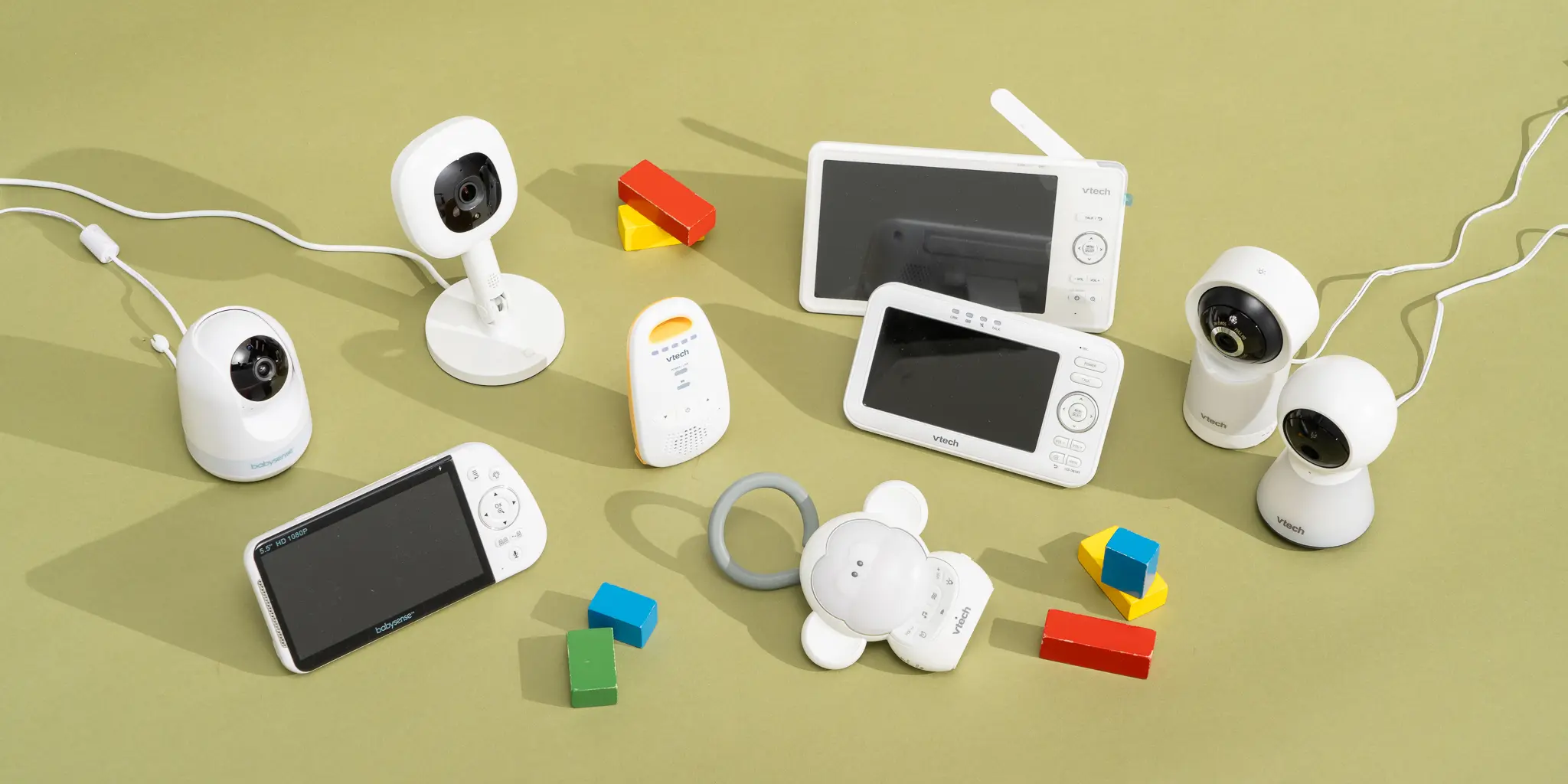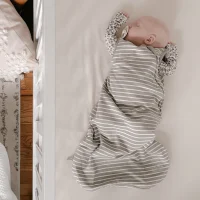Observing your peacefully sleeping infant in vivid clarity, with their gentle breaths visible, can significantly alleviate the stress and worries that often accompany the early stages of parenthood.
The baby monitor industry has made remarkable advancements in recent years. High-definition visuals, crisp audio, extended battery performance that lasts overnight, and durable designs capable of withstanding curious toddlers are now standard features. Many modern monitors also include added conveniences like soft nightlights, customizable white noise options, and even curated video summaries capturing your child’s nighttime movements.
When selecting a monitor, consider your lifestyle needs. Local video monitors, such as the Babysense MaxView Baby Monitor (praised for its reliability and split-screen capabilities), operate within a limited range—typically around 1,000 feet—requiring the parent unit to stay near the nursery. For remote monitoring, Wi-Fi-enabled options like the Nanit Pro Smart Baby Monitor (noted for its sleep-tracking analytics and smartphone integration) allow you to check on your child via a mobile app, whether you’re at a nearby restaurant or traveling for work.
Who this is for
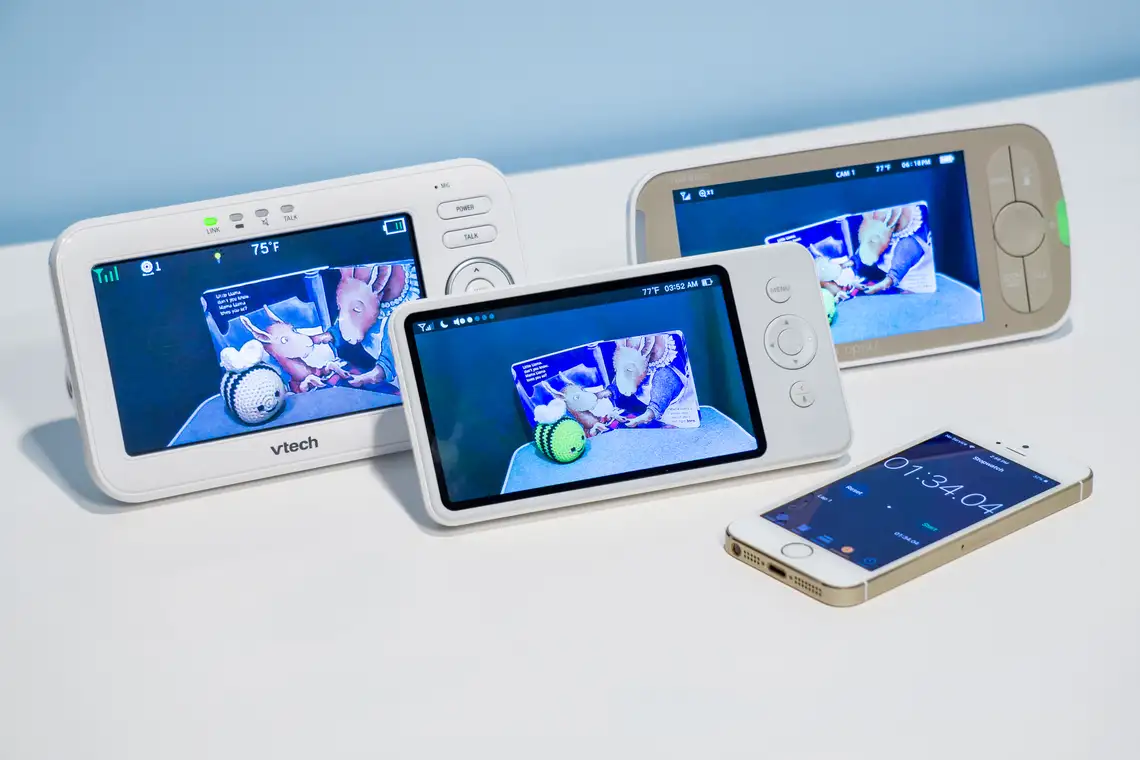
A baby monitor isn’t essential for every family. Those in compact living spaces, who keep their child nearby, or who feel comfortable relying on audible cues (like a baby’s cry, which is usually unmistakable) may find little need for one. Others might use it sporadically—for instance, to keep tabs on a napping infant while gardening or tackling chores outdoors.
For many caregivers, though, these devices become indispensable. Visual reassurance of a sleeping child’s safety in another room can ease anxiety and create peace of mind, making monitors a practical tool for daily routines.
While most commonly used for newborns, monitors retain value beyond infancy. They allow parents to discreetly check if older children are still asleep, staying in bed, or remaining in their rooms. Observing a child’s cozy sleeping positions or quiet moments of independence becomes possible—and often heartwarming—through this simple yet effective technology.
How to choose a baby monitor
Local-video monitors offer straightforward setup, relying on a direct connection between camera and parent unit within a 1,000-foot range (roughly three football fields). The camera requires constant power, while the portable display needs daily charging. Many models provide crisp visuals, allowing clear views of your baby’s room even from a backyard—ideal for parents seeking moments of quiet relaxation nearby.
Wi-Fi monitors, though more complex, enable remote viewing via smartphone apps. These require a stable Wi-Fi connection and involve app setup, raising security considerations. They’re less practical for shared caregiving or travel to areas with unreliable or unsecured networks, where a backup audio monitor is advisable.
Hybrid models combine local connectivity with optional Wi-Fi pairing through apps, though app features are often limited compared to dedicated Wi-Fi monitors. They strike a balance for occasional remote check-ins, such as during evenings out.
Audio-only monitors transmit sound from a plugged-in microphone to a portable receiver within 1,000 feet. Affordable and energy-efficient, these excel in battery life for the parent unit, prioritizing simplicity over visual monitoring.
How we picked and tested
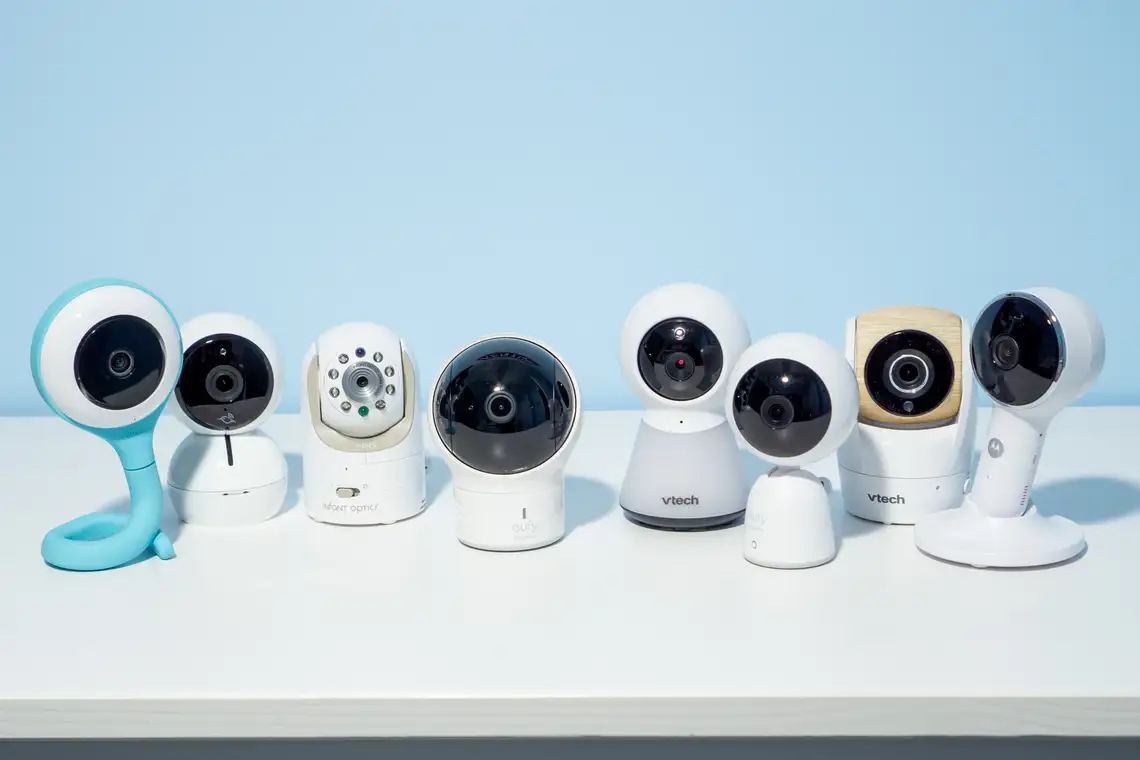
A high-quality baby monitor should prioritize core functionalities that blend practicality with advanced safeguards. Here’s a condensed, rephrased breakdown of essential criteria:
Reliability & Range: For non-Wi-Fi models, a stable connection across multi-story homes or outdoor spaces (e.g., patios) is critical. Wi-Fi monitors, while theoretically unlimited in range via cellular networks, depend on consistent internet access.
User-Friendliness: Setup should be intuitive, with clear instructions or QR-code-guided tutorials. Apps for Wi-Fi models must offer seamless navigation, minimizing parental frustration during late-night checks.
Battery Performance: Rechargeable displays capable of lasting 10–12 hours ensure uninterrupted monitoring during extended sleep periods. Energy-saving modes (e.g., idle screens) and efficient charging further enhance usability.
Visual & Audio Clarity: High-resolution night vision for discerning facial details and crisp audio, even at low volumes, are non-negotiable. Adjustable VOX (voice-activated audio transmission) reduces unnecessary noise while capturing critical sounds like cries.
Durability: Devices must endure accidental drops or toddler interference. Robust construction and secure mounting options (e.g., wall brackets) are key.
Flexibility & Security: Local-video monitors benefit from remote pan/tilt controls and expandable camera systems. Wi-Fi models demand encryption, two-factor authentication, and automatic updates to counter hacking risks.
Added Features: While optional, integrated nightlights, white-noise machines, or temperature sensors (e.g., Cubo Ai’s breathing tracking) add convenience.
Over years of testing across diverse home layouts—from compact apartments to sprawling, multi-story houses—these attributes remain central to identifying monitors that balance functionality, security, and parental peace of mind.
Testing Protocols for Local-Video Monitors
To evaluate night vision performance, we conducted trials in a completely darkened bedroom using blackout curtains and eliminating ambient light sources like night-lights. This setup simulated real-world conditions where clarity in low-light environments is critical.
For battery endurance testing, monitors were configured to mimic typical parental usage: screens set to near-maximum brightness and audio at low volume. A time-lapse recording captured each device’s runtime alongside a synchronized stopwatch, providing precise measurements of battery depletion timelines. This method ensured accuracy in assessing practical longevity for overnight monitoring needs.
Evaluating Audio Monitor Performance
To assess sound quality and transmission range, we analyzed audio degradation as distance increased from the nursery, identifying when clarity diminished. Two-way communication functionality was tested for responsiveness and usability, prioritizing monitors with intuitive push-to-talk features that avoided metallic distortion or overly complex interfaces—critical for caregivers needing to reassure a child promptly.
During extended in-home trials, clarity was evaluated by playing low-volume story podcasts to determine which devices accurately reproduced subtle sounds, even when monitored remotely (e.g., from a nearby street). This tested real-world scenarios where nuanced audio capture matters.
Battery endurance was measured by tracking runtime without recharging, simulating typical usage patterns. This provided insights into practical reliability for overnight or extended monitoring needs.
Our pick: Babysense MaxView Baby Monitor
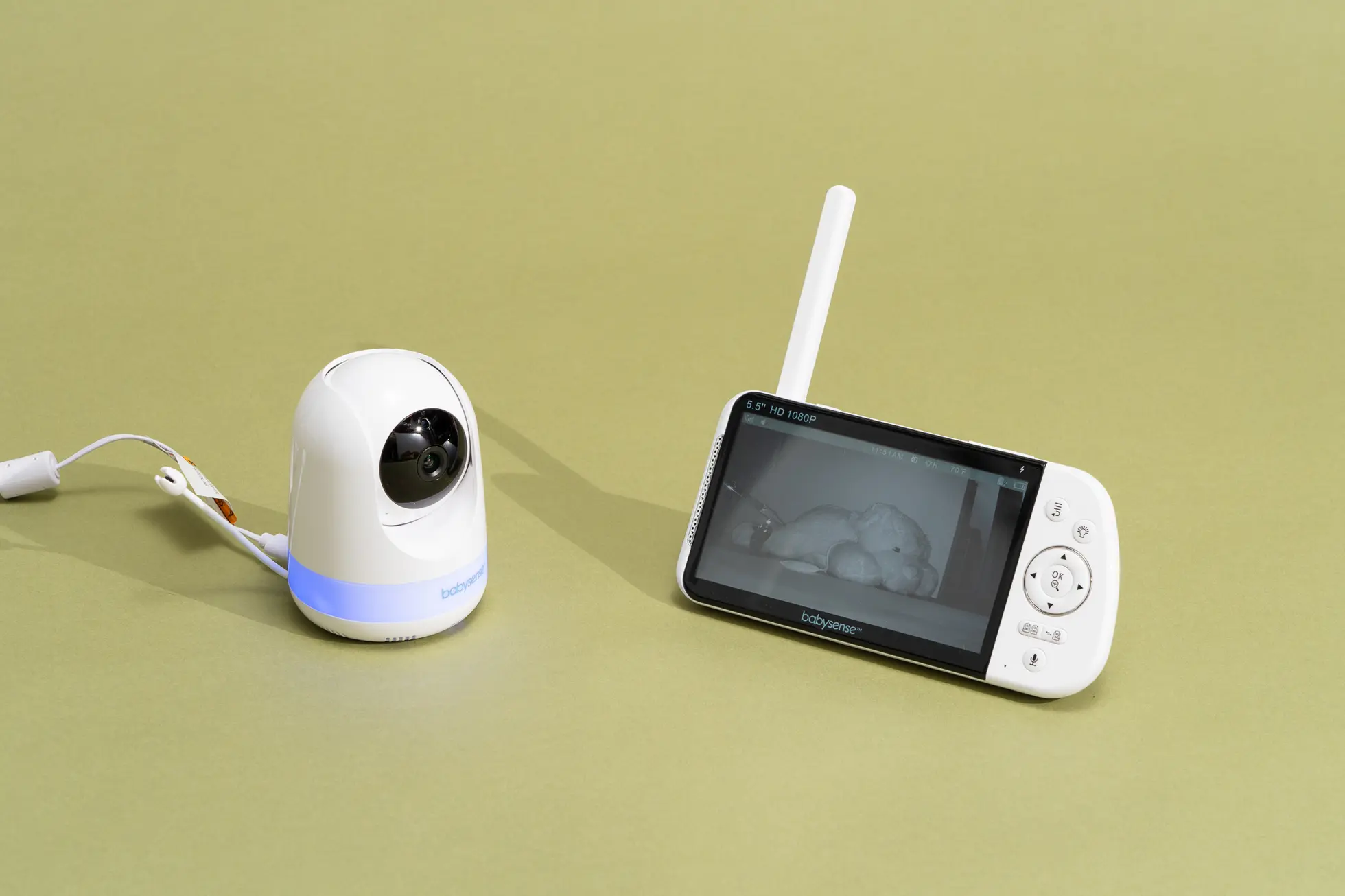
The Babysense MaxView Baby Monitor outperforms other local-video models with its sharp 1080p video, lifelike audio, and expansive screen that captures subtle details. Additional features like customizable white noise, lullabies, a night-light, and an external temperature sensor enhance its versatility. While the side-mounted volume indicator may disturb light-sensitive users, the monitor excels in reliability: Its battery lasted over 12 hours in testing (extendable to 20 hours in eco mode), and its 1,000-foot range maintained a stable connection across multi-story homes and outdoor distances.
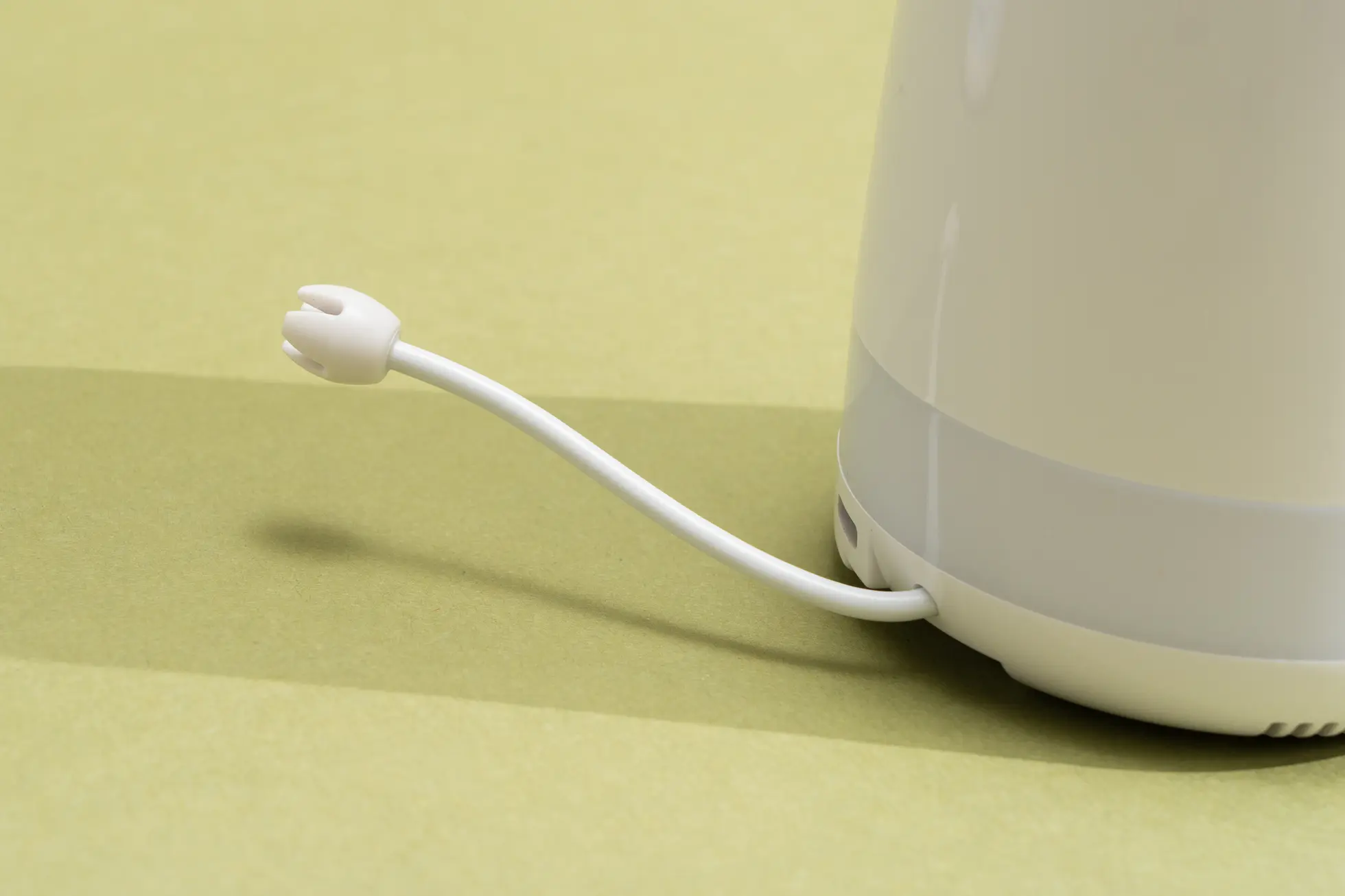 The camera delivers crisp daytime visuals with accurate color reproduction and readable text via zoom, while night mode provides clear, low-grain views of a child’s movements. The responsive display allows swift camera adjustments—355-degree horizontal rotation and 90-degree tilt—ideal for monitoring multiple children or scanning a room. Convenient shortcuts include an instant talk-back button with minimal delay and a one-touch night-light for quick nighttime checks.
The camera delivers crisp daytime visuals with accurate color reproduction and readable text via zoom, while night mode provides clear, low-grain views of a child’s movements. The responsive display allows swift camera adjustments—355-degree horizontal rotation and 90-degree tilt—ideal for monitoring multiple children or scanning a room. Convenient shortcuts include an instant talk-back button with minimal delay and a one-touch night-light for quick nighttime checks.
Audio clarity stands out, with true-to-life sound transmission and adjustable noise cancellation (VOX) to filter background hums. Built-in white noise or lullabies can be set to timed intervals. Practical touches include USB-C charging cables for easy replacements and seamless multi-camera support (up to four cameras per display), which can be added in seconds without menu navigation.
Babysense backs the monitor with a 90-day return window and a one-year warranty (extendable to 18 months upon registration), solidifying its appeal for parents prioritizing functionality and adaptability.
Notable Limitations
The display’s side-mounted sound indicator emits a noticeable glow in dark settings, which cannot be dimmed or disabled. Light-sensitive users might find this distracting, though placing the display face-down or covering the bar with tape (an imperfect fix) allows audio to function normally.
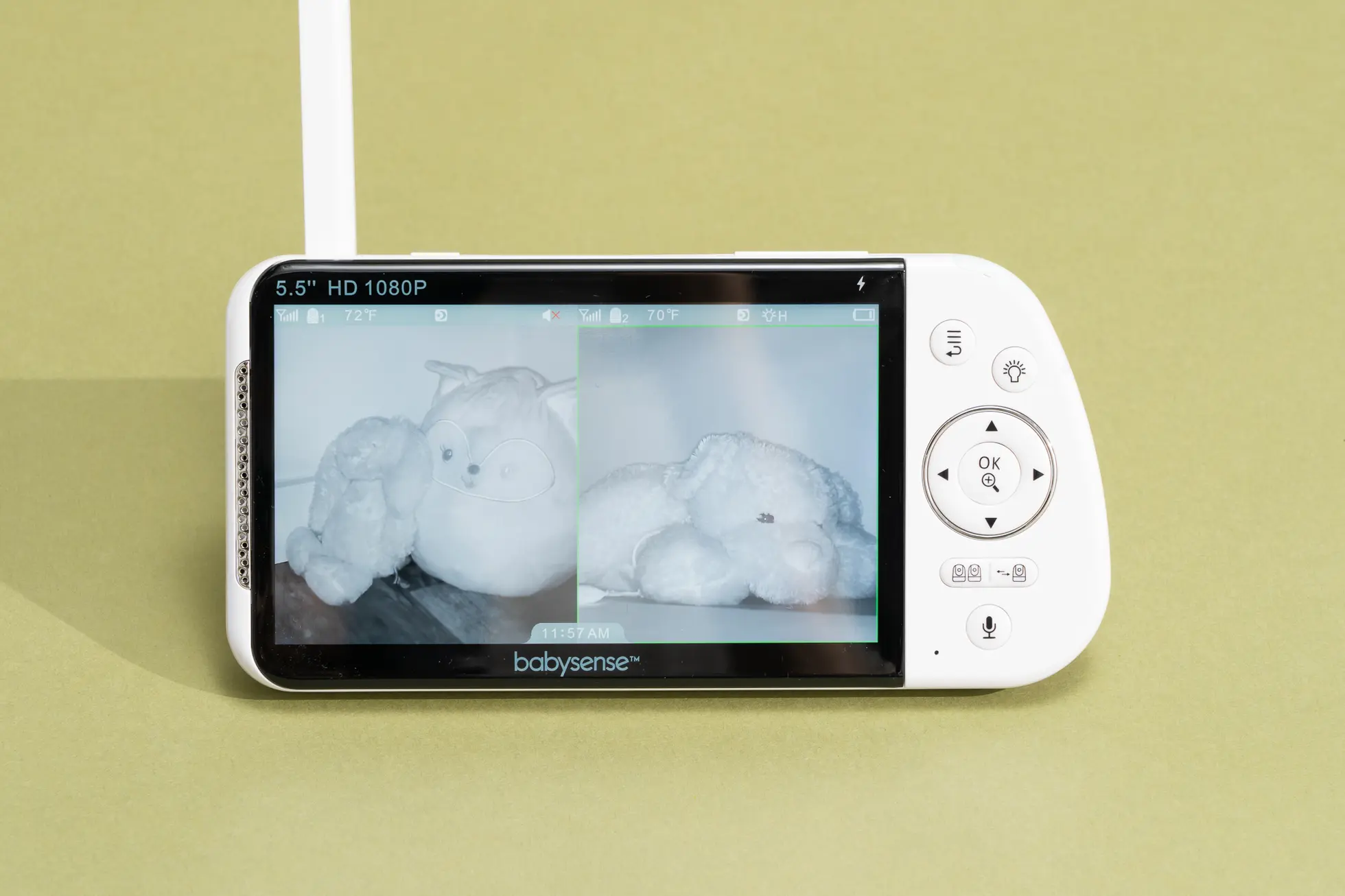
While the monitor’s buttons feel plasticky and less refined compared to softer-touch alternatives, their layout simplifies menu navigation, minimizing frustration during use.
Multi-camera audio monitoring requires manual configuration. Though a “scan mode” cycles through feeds in 10-second intervals (leaving one camera muted at a time), enabling this feature involves consulting the manual. For uninterrupted audio from multiple rooms, manual checks or opting for a Wi-Fi model like the Nanit Pro may be preferable. These quirks, while inconvenient, don’t overshadow the monitor’s core strengths.
Budget pick: VTech VM5254 local-video monitor

The VTech VM5254 stands out among budget-friendly local-video monitors, which often compromise on build quality and performance. While its screen resolution and viewing angles fall short of premium models, this monitor delivers respectable video and audio clarity for its price range. It features a 5-inch display, reliable connectivity across multi-story homes, and a battery life comparable to higher-end options—lasting approximately 12 hours per charge.
Designed for practicality, it maintains stable connections even during extended outdoor testing, though image quality gradually degrades at longer distances. A notable feature is its noise-activated night light, which automatically illuminates upon detecting sound—ideal for navigating dark nurseries without manual adjustments.

Travel-friendly extras elevate its value: built-in lullabies and white noise eliminate the need for additional devices, while a room-temperature display offers convenience (despite slight calibration discrepancies in testing). The monitor’s portability and intuitive controls make it adaptable for both daily use and trips.
Backed by a one-year limited warranty, the VM5254 balances affordability with functional versatility, though its plastic buttons and basic camera mechanics reflect its budget positioning.
Flaws but not dealbreakers
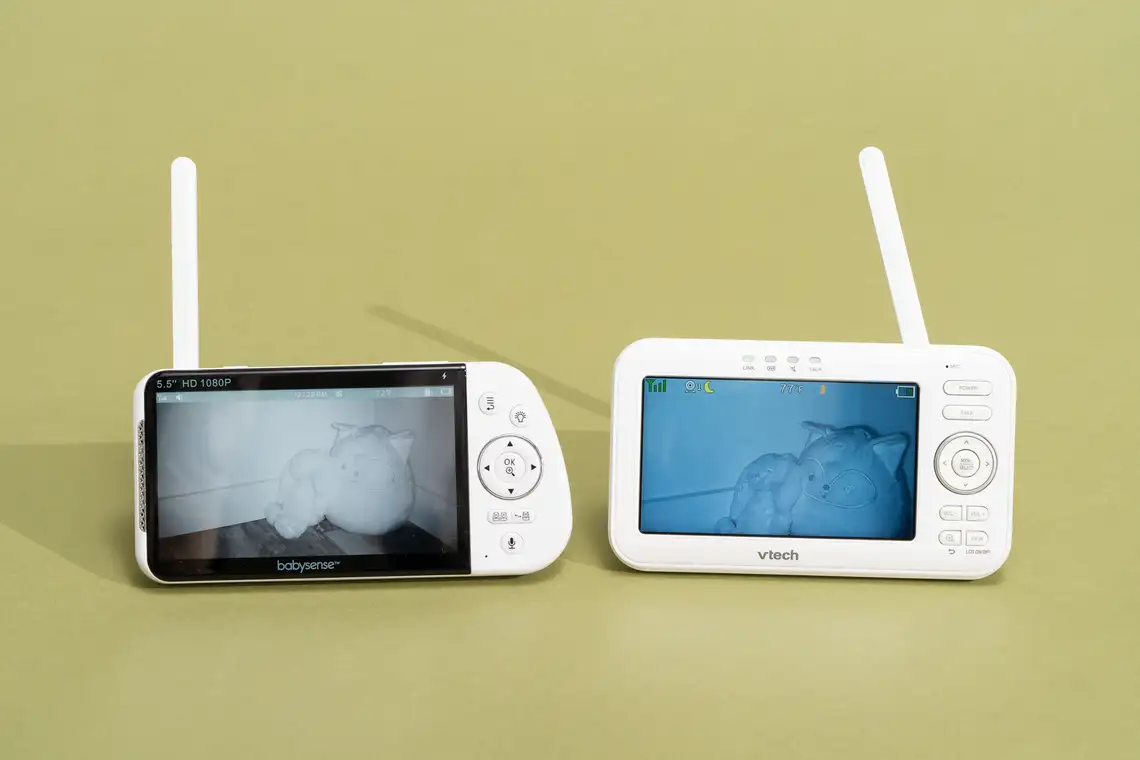
The camera’s narrow viewing angle requires careful placement during installation to capture more than just the crib area. Unlike models with wider lenses, positioning must be precise to avoid missing peripheral details.
Video quality falls short of competitors, limited to 480p resolution. This results in softer, less detailed imagery and muted colors compared to higher-resolution monitors, though basic monitoring remains functional.
VTech’s reliance on proprietary charging cables adds inconvenience. Lost or forgotten adapters necessitate purchasing replacements directly from the brand, unlike USB-C-compatible alternatives.
Expanding the system is restrictive. Users needing additional cameras must buy a pre-packaged two-camera model (VM5255-2) rather than adding single units post-purchase, limiting flexibility for growing monitoring needs.
Our pick: Nanit Pro Smart Baby Monitor
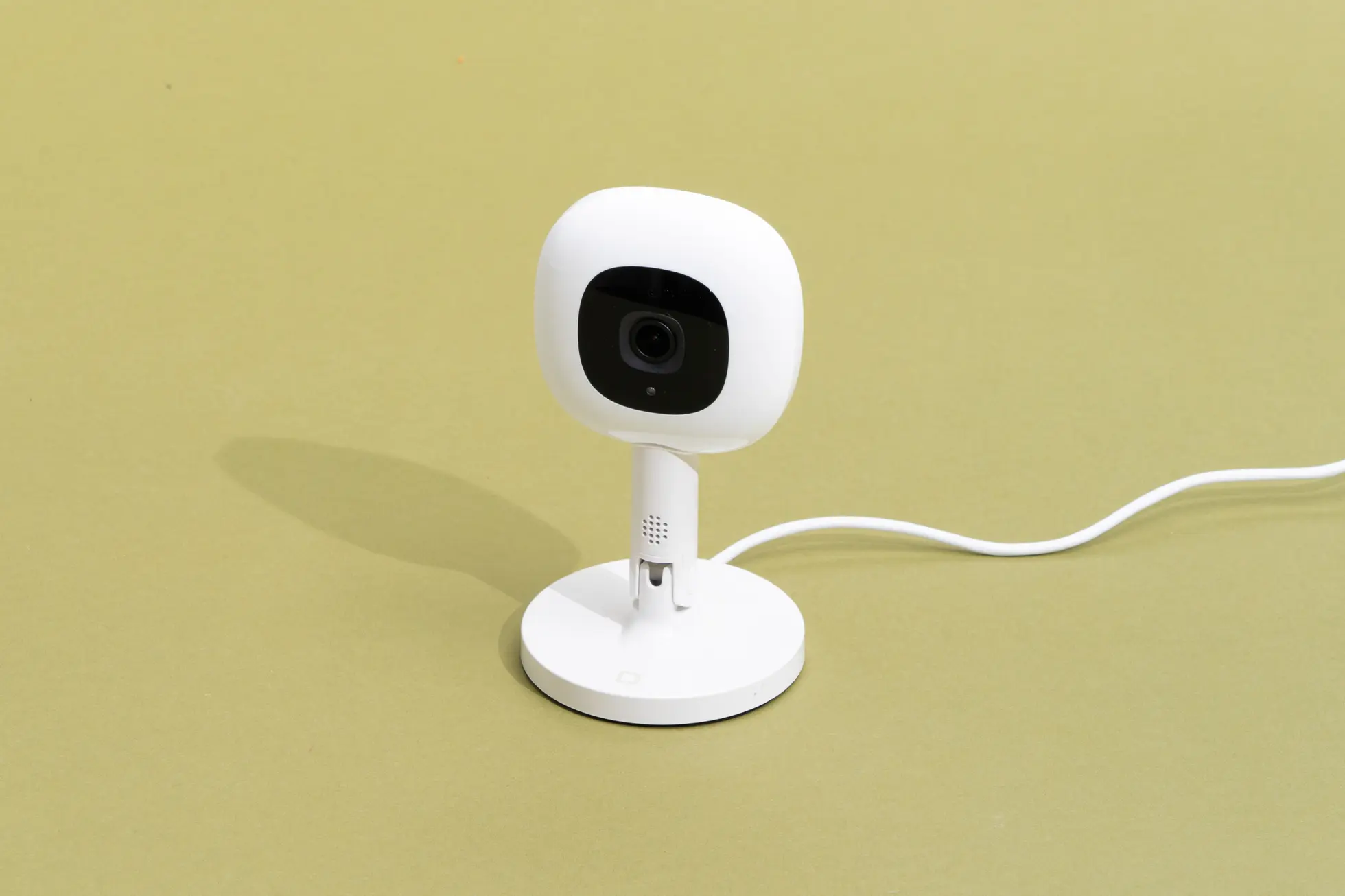
The Nanit Pro Smart Baby Monitor (available in wall-mount or floor-stand configurations) combines high-tech convenience with polished design. Though we initially sought simpler options, its feature-rich ecosystem won us over. The Wi-Fi-enabled camera streams crisp 1080p video—sharp in daylight and impressively clear in low light—to a smartphone app, enabling remote viewing from any location. Audio remains uninterrupted even when using other phone functions, a rarity among app-based monitors.
Nanit prioritizes security with robust encryption and an intuitive app interface. However, advanced analytics like sleep tracking require a $50+ annual subscription after the initial six-month trial, which may deter some users long-term.
The camera’s modular design shines: Choose between a wall mount, floor stand (both include anti-tangle cord covers), or portable Flex Stand. While the Flex Stand offers flexible placement, its lateral view limits sleep-data collection compared to the overhead perspective enabled by fixed mounts. The compact, wallet-sized camera feels durable, and its minimalist aesthetic blends well with nursery decor.

The Nanit Pro Camera offers a straightforward setup process: Connecting it to Wi-Fi (compatible with 2.4 GHz, 5 GHz, or dual-band routers) requires about five minutes. Users simply download the app, create an account, and follow in-app pairing instructions while the camera’s indicator light blinks.
Expanding the system is seamless. Unlike most monitors, Nanit recently introduced a split-screen feature that simultaneously displays video and audio from two cameras—a unique capability among competitors. Sound streams continuously from multiple feeds without interruption, whether monitoring from the app or using background audio while navigating other phone functions.
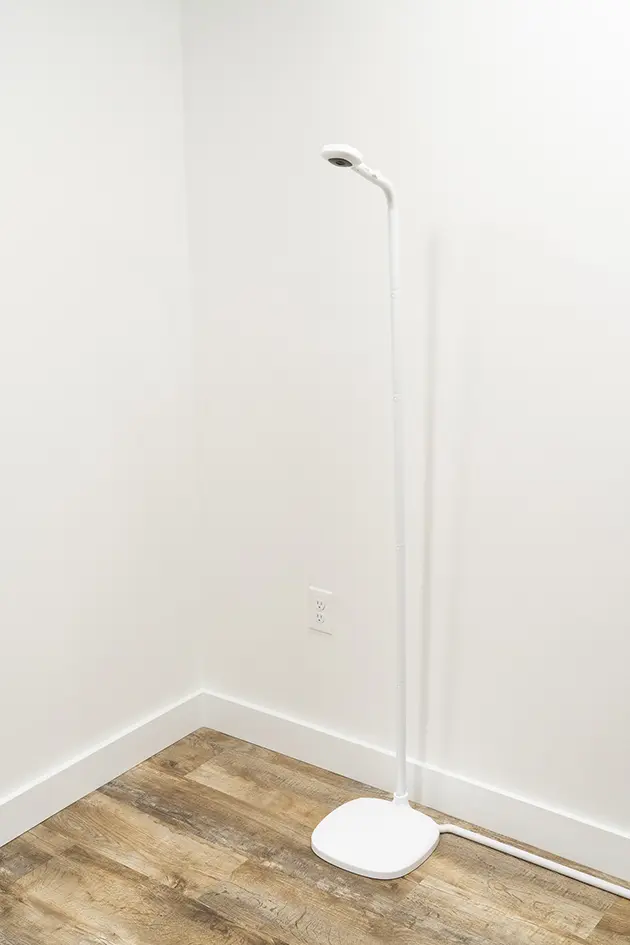
Nanit prioritizes security with rigorous measures to safeguard against unauthorized access. Unlike many competitors, it employs 256-bit AES encryption
The intuitive app combines monitoring tools with parental controls. Beyond real-time HD video and environmental tracking (temperature/humidity), it offers two-way communication, customizable white noise/nature sounds, and programmable night-light dimming for nighttime care. Automatic motion/sound-triggered video clips can be manually saved, while background audio persists during phone multitasking.
For remote caregivers, Nanit’s analytics reveal sleep patterns through daily condensed recaps. Customizable activity alerts notify users of specific crib movements like standing infants, though optimal functionality requires strict camera placement along the crib’s long side—a persistent design limitation despite user feedback. These features collectively empower data-driven caregiving, whether tracking developmental milestones or coordinating with alternate caregivers.
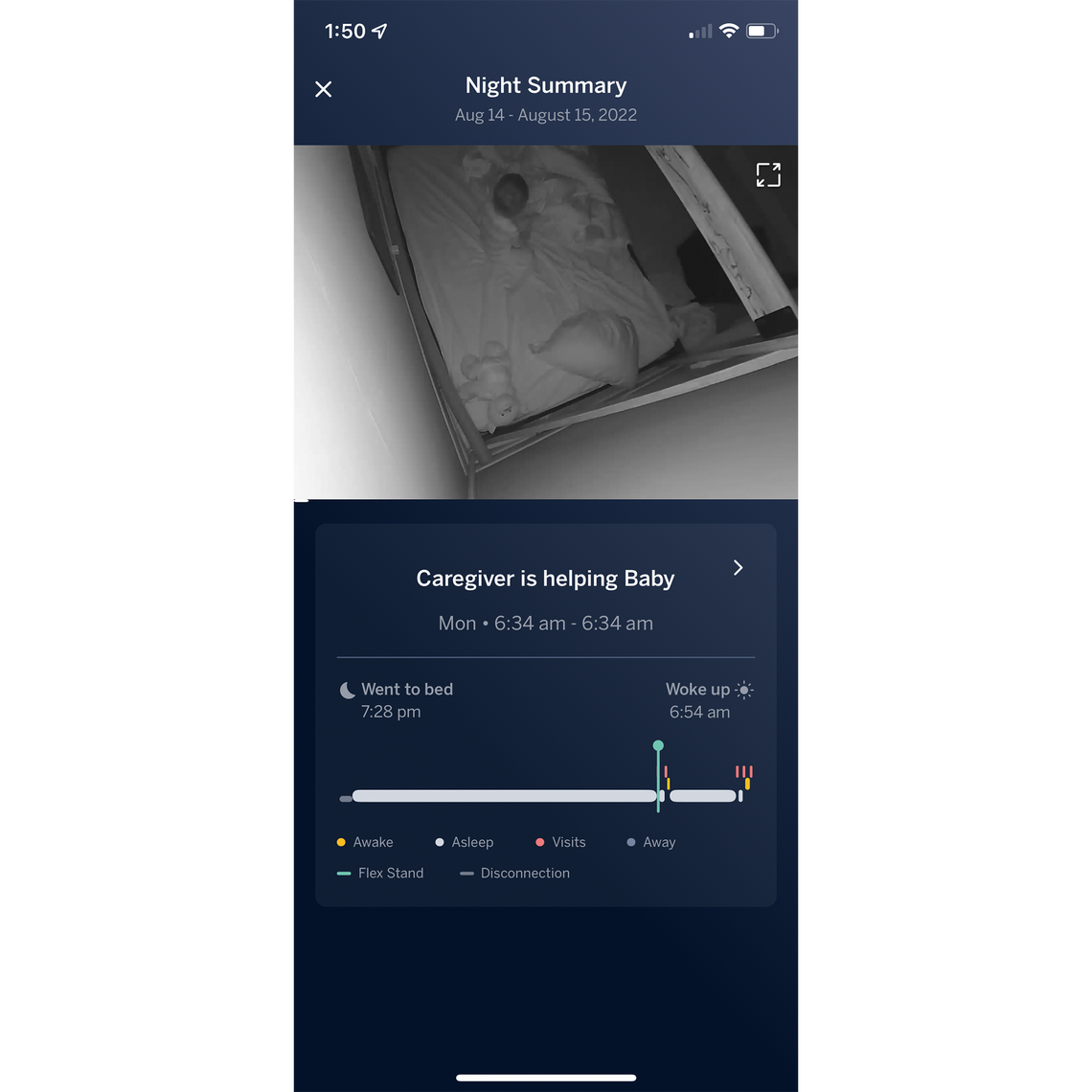
The Nanit Pro app supports multi-device compatibility, allowing caregivers to access feeds across multiple smartphones or tablets. For optimal use, consider dedicating a secondary device (like an old Android phone) as a primary home display to avoid disruptions from calls or notifications on your daily phone. While background audio may pause during phone activity, video streams persist as a small overlay window, enabling multitasking without interrupting monitoring.
Covered by a one-year limited warranty, the Nanit Pro balances advanced features with practical adaptability, though users should plan for potential subscription costs post-trial.
Flaws but not dealbreakers
The Nanit Pro lacks remote camera adjustment capabilities, as its app provides no controls to modify the viewing angle in any stand configuration. While manual swiveling is possible, users accustomed to standard pan/tilt features on local-video monitors may find this restrictive.
After a six-month introductory period, core analytics and smart alerts become subscription-dependent. Without an Insights Plan, functionality reverts to basic live streaming, single-user access, and night-light controls—severely limiting features like sleep tracking and multi-camera split-screen viewing.
The app’s persistent sleep-training prompts may feel intrusive. Default notifications encourage methods like “drowsy-but-awake” placement and paid expert consultations. Opt-out settings exist but don’t silence all sleep-related nudges, leaving residual prompts that some users find overbearing.
Reliability hinges on stable power and internet. Though the camera maintains local Wi-Fi streaming during brief outages, frequent internet disruptions render it less dependable than non-Wi-Fi monitors. Extended blackouts disable all functionality unless backup power sources sustain the router.
Also great: VTech RM7766HD Wi-Fi and local-video monitor
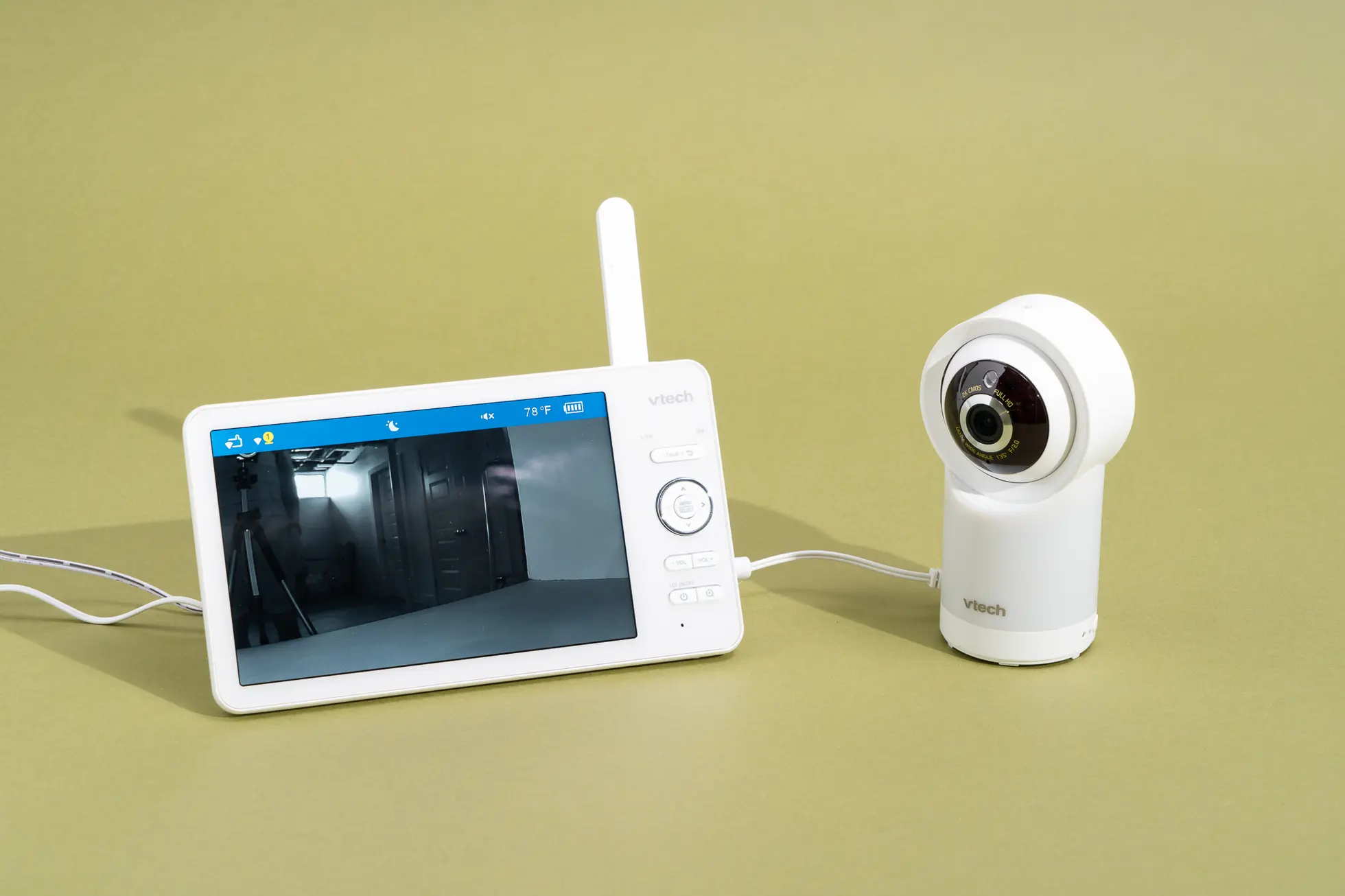
The VTech RM7766HD hybrid monitor blends local-video reliability with optional Wi-Fi connectivity, ideal for parents prioritizing simplicity at home but desiring remote access during travel. Unlike subscription-dependent competitors, its companion app remains free (albeit basic) indefinitely.
Video clarity excels, particularly in night mode. Testing revealed sharper imagery than most local or Wi-Fi monitors, even when employing the 24x optical zoom to scrutinize fine details like facial expressions or crib movements. This hybrid model outperforms many dedicated devices, offering versatility without compromising core functionality.
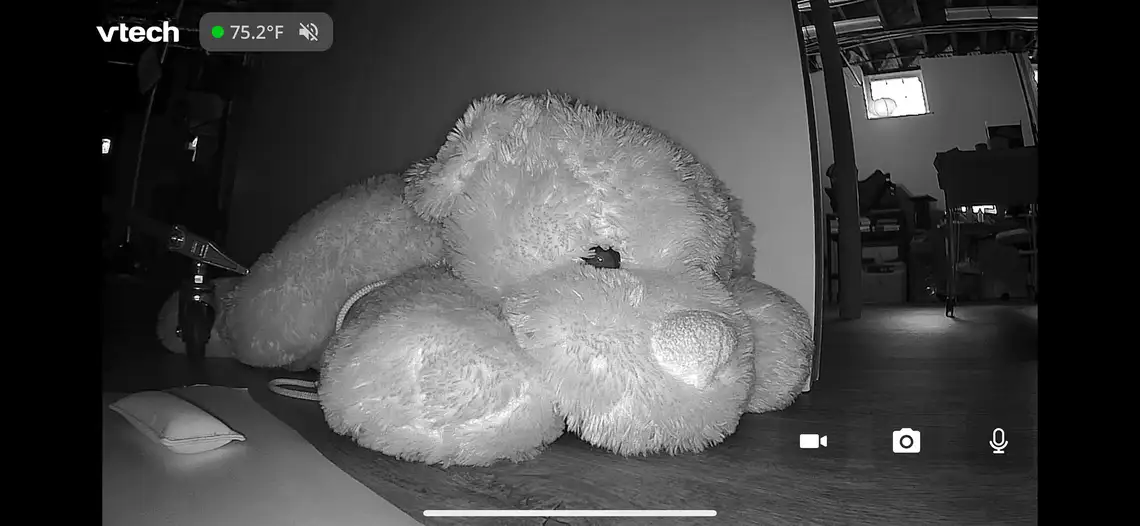
The VTech RM7766HD hybrid monitor delivers reliable coverage, maintaining a stable local-video signal up to four houses away. If Wi-Fi drops during home use, it automatically switches to local mode within roughly a minute, ensuring uninterrupted monitoring without manual adjustments.
At home, users can alternate between the dedicated display and smartphone app when connected via Wi-Fi. Local mode restricts viewing to the display, while remote access relies solely on Wi-Fi or cellular data.
Setup is streamlined: On-screen prompts guide camera pairing, app installation (via QR code), and Wi-Fi configuration. Though optimized for 2.4 GHz networks, it performed seamlessly on dual-band connections during testing, simplifying initial installation.
The VTech RM7766HD meets essential security benchmarks with QR code authentication for initial app pairing, preventing unauthorized remote access unless physically near the camera. Data encryption during transmission further safeguards feeds from interception.
Warranty coverage includes a standard one-year limited manufacturer guarantee, though returns require proof of purchase and retention of original packaging—a common but notable stipulation for eligibility.
Flaws but not dealbreakers
The RM7766HD struggles with low-volume sound transmission. Subtle ambient noises, like a white-noise machine’s hum—clearly audible on higher-end models—were imperceptible even at maximum volume settings.
Unlike the Nanit Pro, its app lacks background audio persistence. Exiting the app or switching phone functions silences the feed, eliminating the convenience of continuous monitoring during multitasking.
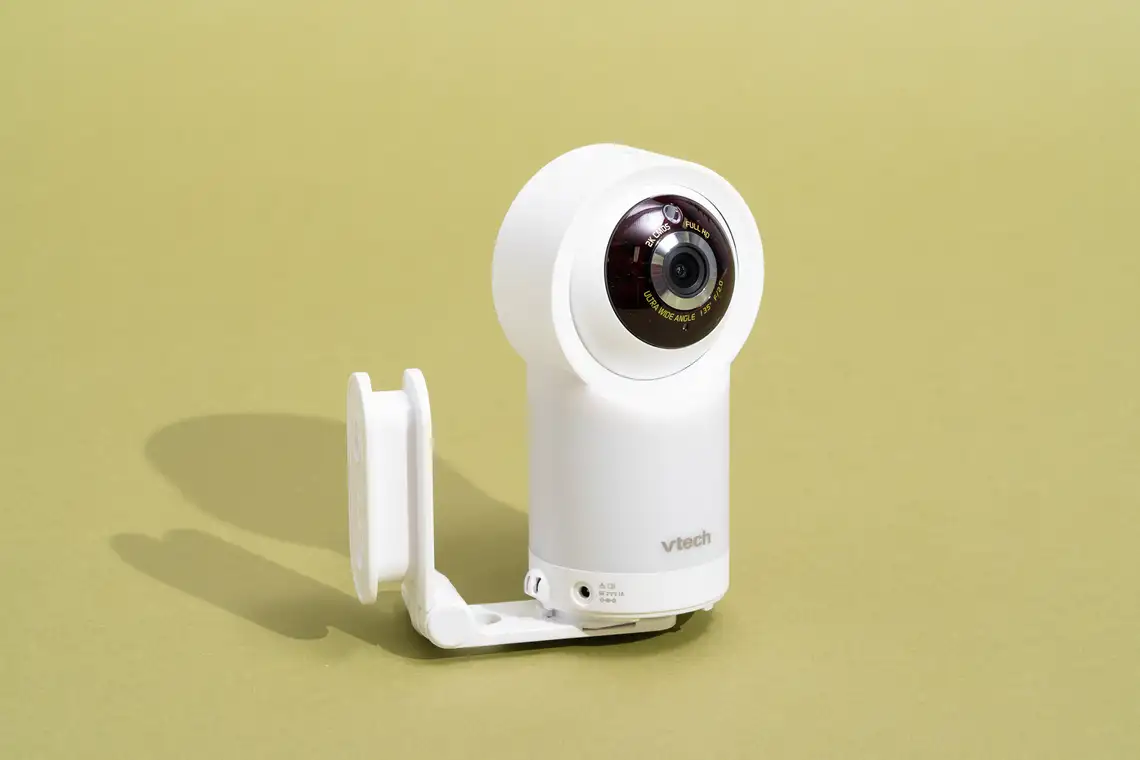
App functionality remains basic: Two-way talk, sound/music playback, and a seven-second clip review are included, but advanced features like sleep analytics or downloadable motion-triggered videos (standard on Nanit) are absent.
Cable length may complicate placement. The included 6.5-foot power cord falls short compared to Nanit’s 8- or 14-foot options, potentially limiting positioning flexibility in rooms with distant outlets.
Camera expansion requires upfront planning. Users needing multiple feeds must purchase the pre-bundled RM7766-2HD model, as adding individual cameras post-purchase isn’t supported.
